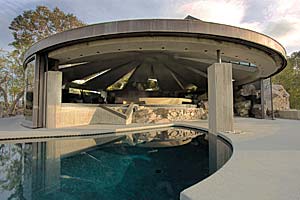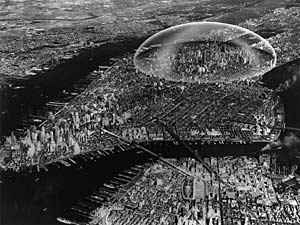Even when Saarinen’s designs were gratuitously exhibitionistic, they never descended into mere styling, which cannot be said of the work of his year-younger contemporary John Lautner, who outlived him by more than three decades. Lautner has been posited as America’s answer to Oscar Niemeyer, the Brazilian master whose critical status has had its ups and downs during his hundred-year life span. Both these architects are superficially alike in their flair for creating sculpturally arresting structures that relate to dramatic natural settings without exactly accommodating them. Beyond that, it’s apples and guavas.


A Niemeyer retrospective I saw in Paris five years ago made me realize what a profound social impulse underpins even his most seemingly willful forms, even in monumental and problematic public commissions such as his start-from-scratch capital city Brasilia. Nothing of the sort emanates from Lautner’s predominantly residential corpus, and not simply because private houses by definition do not affect society in the same way urban planning does.
Saarinen’s inconsistency has bothered some critics, but an architect’s doing too much of the same wrong thing — in Lautner’s case, showpiece vacation houses in remote redoubts for the very rich — can have a deadening effect. Perhaps one or two of his flying-saucer-on-a-hilltop extravaganzas might be tolerable; seen in the quantity required by the retrospective format, their cumulative effect is oppressive and off-putting.
A modern house need not be Charles Moore cozy to promote what he called “the indwelling spirit,” and people are entitled to live however they choose. But for me, Lautner’s overbearing aesthetic embodies some of the least attractive American traits — overindulged individualism, size fetishism, and sham environmentalism. If you want a true midcentury maverick, stick with Bruce Goff, a whiz with the turkey feathers, anthracite coal, and indoor-outdoor carpeting he used to clad his incontestably original prairie houses — antitheses of Lautner’s repetitive, contoured-concrete, panoramic-view Playboy pads.
The rediscovery of Bucky Fuller seems preordained amid growing nostalgia for the heady days when he coined the term “Spaceship Earth,” among his many resonant catchphrases. A quintessential late bloomer who hit his stride only as he hit 70, this high-tech Maharishi was paradoxically revered by the ’60s don’t-trust-anyone-over-30 brigade. Now, in a world bulging with blobitecture, Fuller’s best-known invention — the geodesic dome — seems pretty tame stuff, and its sievelike porosity has made it an engineering dinosaur. But in his heyday, those lightweight all-purpose shelters seemed as entrancing as a kaleidoscope to a tripping hippie.
Fuller — a logomaniac who made the garrulous Louis Kahn seem like a Beckett monosyllablist — proffered urban-scaled fantasy projects so grandiose and impractical that no amount of technical know-how could have brought them to fruition. But he inspired an international generation of visionary designers and planners — particularly Team X in Britain and the Metabolists in Japan — who executed a number of his concepts as he never could.
Several schemes by Fuller’s followers are not in the Whitney’s poorly presented and inadequately argued overview, but instead show up in the best architectural exhibition held in many years at MoMA (or anywhere else, for that matter). Although Home Delivery ranges from a century before and a half-century after the postwar decades when Saarinen, Fuller, and Lautner were riding high, this thoughtful, thematic investigation of one of Moderrnism’s grandest obsessions — architectural prefabrication — conveys the same uplifting aura of open-ended possibility promoted by those three true believers in tomorrow.
Organized by MoMA’s chief curator of architecture and design, Barry Bergdoll (assisted by Peter Christensen), Home Delivery delivers not only scholarly depth and critical insight, but revives MoMA’s most historic contribution to architectural museology: the construction of full-scale model houses. This proven solution to architectural illiteracy lets nonprofessionals experience the real thing rather than simulacra — models, drawings, photos, or partial mock-ups found in routine gallery presentations of the building art.
At the Home Delivery press preview, Bergdoll wryly alluded to his having learned the hard way why prefabrication was never adopted as fully as its pioneering proponents predicted: The daunting economics of constructing the show’s five relatively modest demonstration houses brought home to him, as no amount of theoretical contemplation could, the financial facts of life that have kept a long-cherished architectural dream from becoming a widespread reality. But that does not prevent this exhilarating exhibition — undeceived and equally informed by its subject’s checkered past and uncertain future — from communicating the hope for a better world that lies at the heart of the still-unfinished Modernist project.




Post a comment to this article
Report Abusive Comment